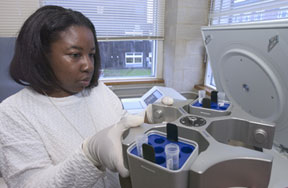| |
 
Summer 2005, Vol. 1, No. 3 | Back to Index

Meet Kimberlei Richardson, Ph.D.,
Grass Fellow, Whitman 323
 |
| At the MBL, Kim studies the effects of the drug clonidine and its possible use as a treatment for heroin-exposed infants |
“My equipment has arrived, I’m preparing samples, and working hard to achieve all the objectives I’ve set for this summer,” says Kimberlei Richardson, a Grass Fellow and 2004 Summer Program in Neuroscience, Ethics, and Survival (SPINES) alumna, who is a second-year postdoctoral research fellow in the Pediatrics Department at Johns Hopkins University Hospital.
Through her research, Kim is tackling a problem that some 350,000 babies are born with each year: opiate addiction. “Baltimore has a high proportion of heroin-exposed infants,” she says. Opiate withdrawal in infants is known as neonatal abstinence syndrome. This syndrome is characterized by high-pitched crying, inconsolability, increased muscle tone, tremors, vomiting, diarrhea, and in severe cases, seizures.
“The traditional treatment for reducing these symptoms of withdrawal in babies is a tincture of opium, a diluted form of morphine. But the optimal therapy is to treat them with an agent that’s non-addictive,” Kim says.
|
|
|
|
Basic and clinical research targeting the cellular and molecular mechanisms underlying the development of opiate dependence and withdrawal in the infants are needed. So this summer, Kim is using neonatal rat models to study the problem at the cellular and molecular level. She is examining the role of a neurotransmitter called norepinephrine, which is released in high amounts during withdrawal, and its influence on specific brain regions believed to be associated with opiate withdrawal. The increased release of norepinephrine is believed to be the cause of physical withdrawal symptoms.
Kim is especially interested in the effects of a norepinephrine-blocking drug called clonidine and its possible use as a treatment for heroin-exposed infants. The drug, which is traditionally used for treating high blood pressure, has been shown to relieve withdrawal symptoms in adult humans and is currently being used in a randomized double-blind clinical trial by Kimberlei’s mentor, Dr. Estelle B. Gauda, at Johns Hopkins Hospital for the treatment of withdrawal symptoms in newborn infants (the trial is supported by the National Institute on Drug Abuse and the National Institutes of Health).
“The effects of clonidine on withdrawal symptoms are documented in adults but not conclusively in infants,” says Kim, who hopes her studies will shed light on the drug’s use as a possible non-addictive treatment for babies undergoing withdrawal. “The goal is to extrapolate information from animal models, which will ultimately help clinicians decide which therapies are best for neonates who display opiate withdrawal symptoms,” she says. |
The New Collecting Net is an employee newsletter published by the Communications Office. Comments and suggestions are welcome. Call (508) 289-7423 or e-mail us at
 |